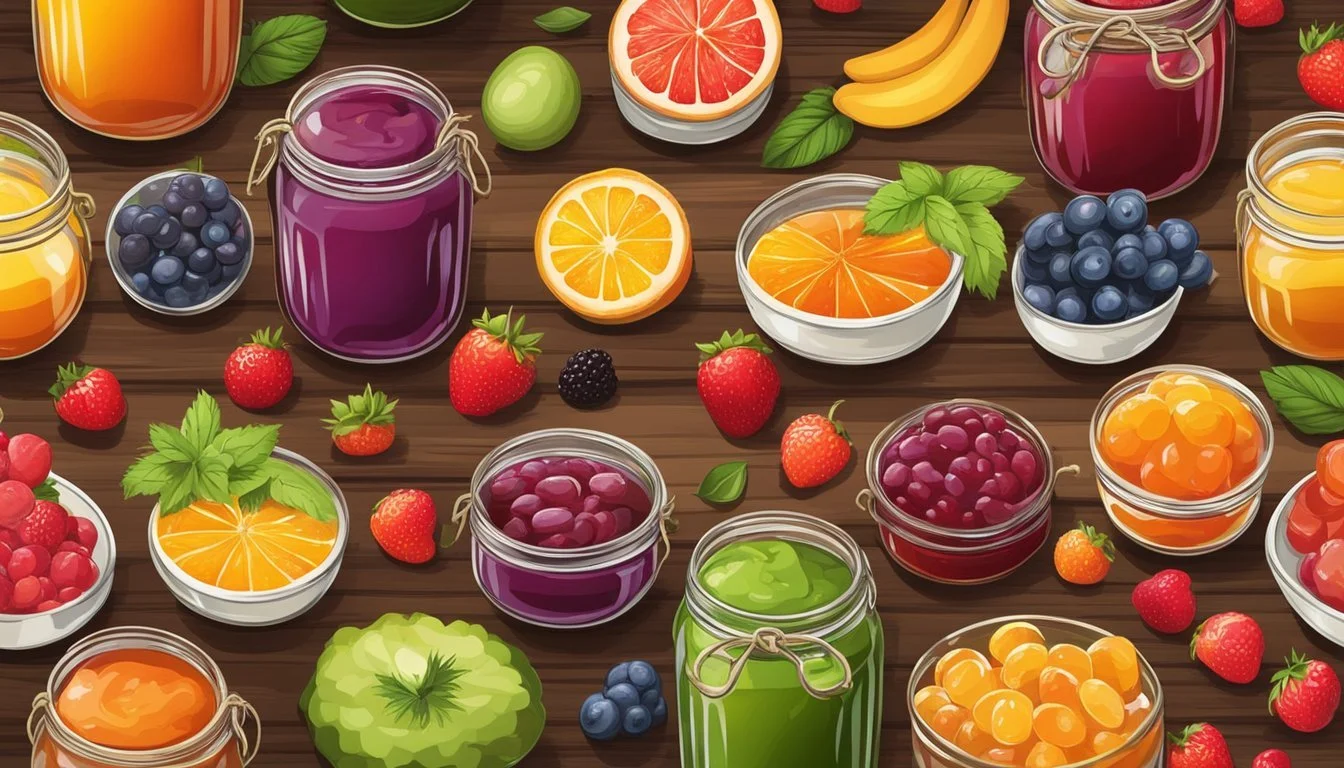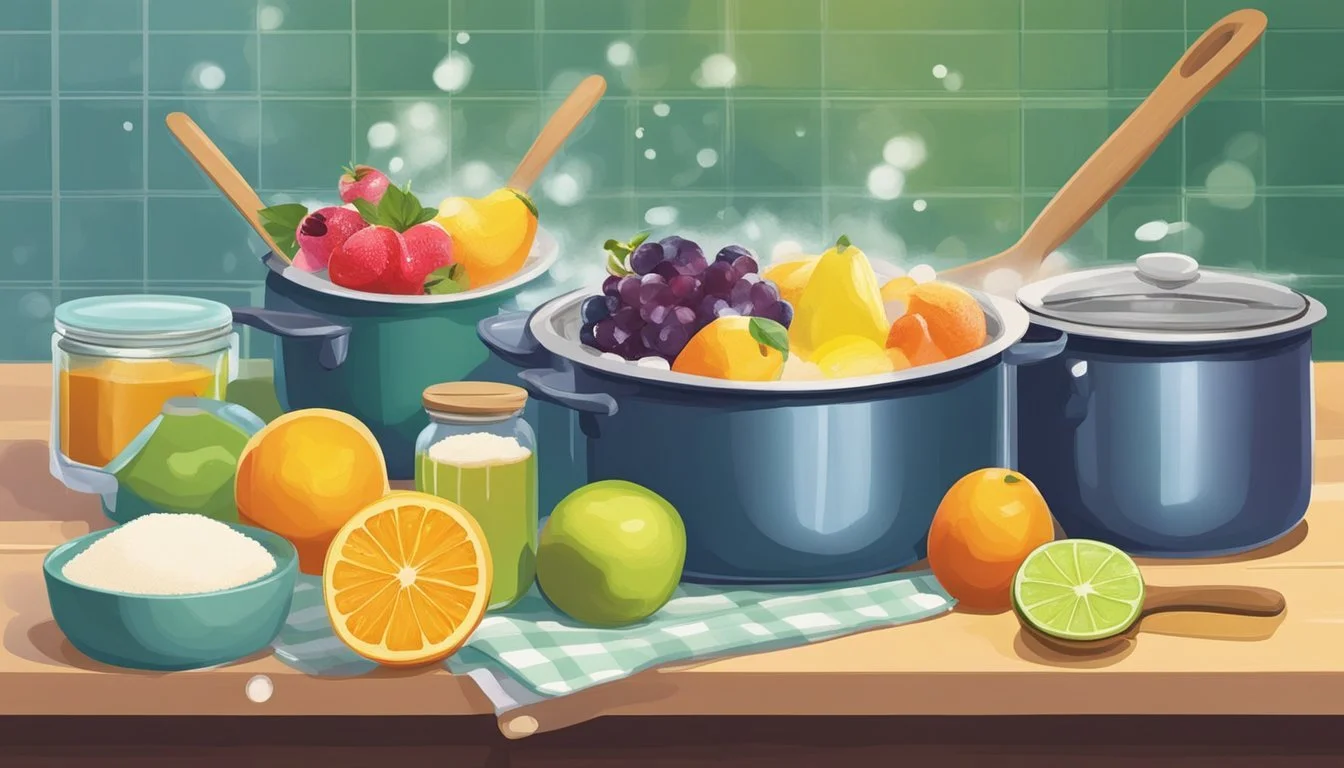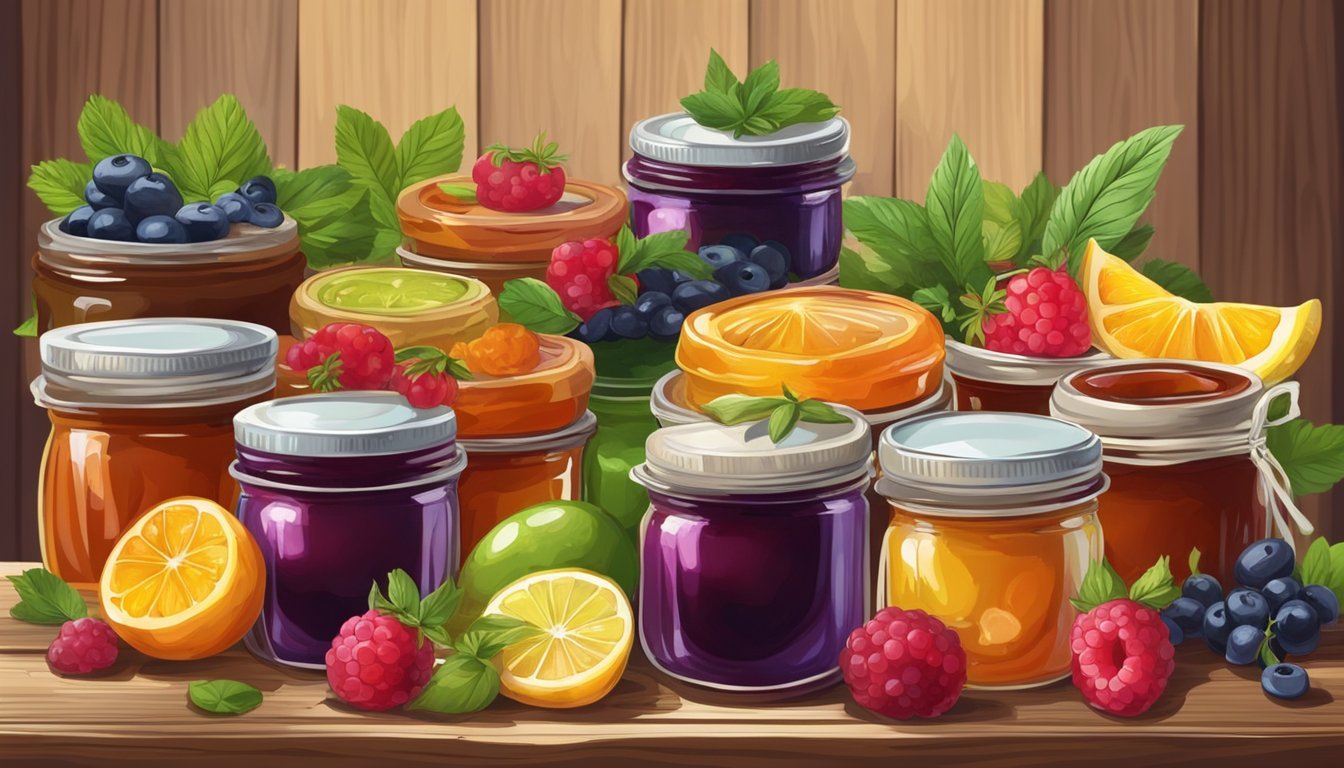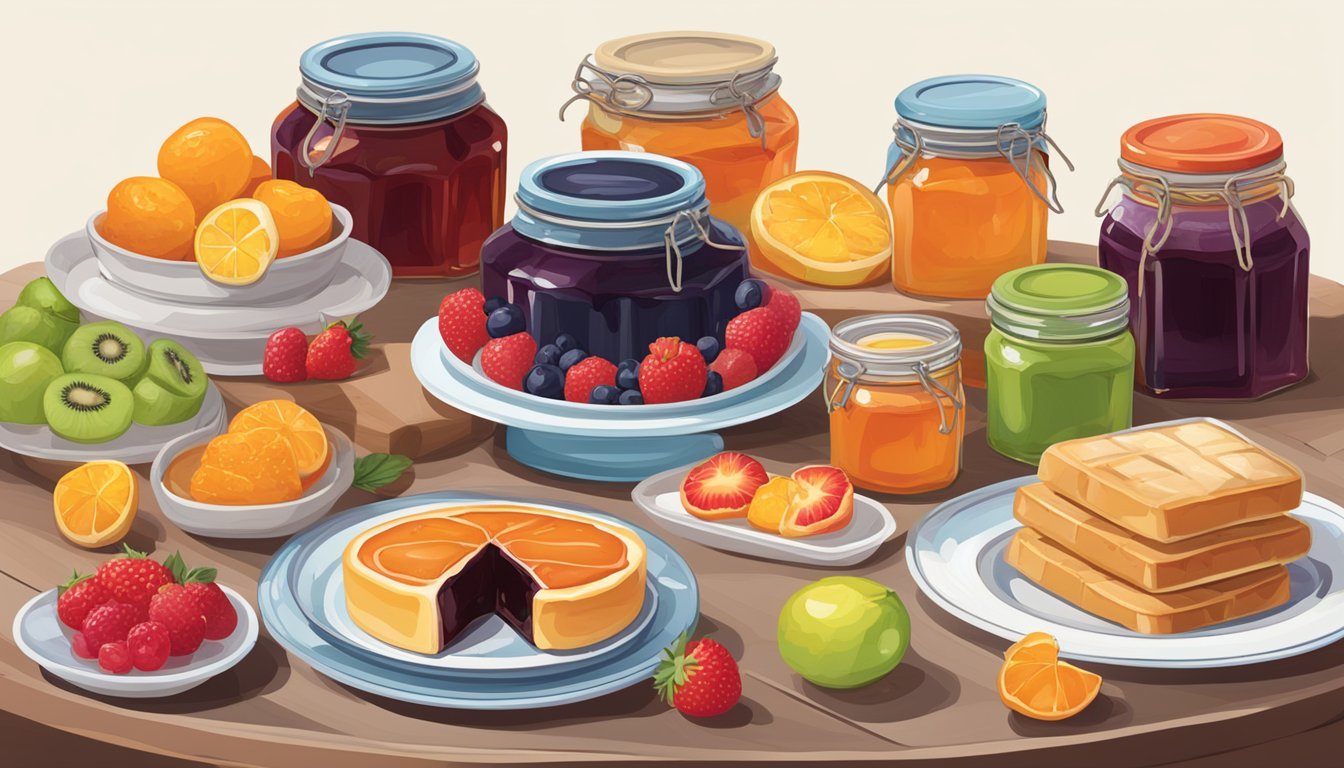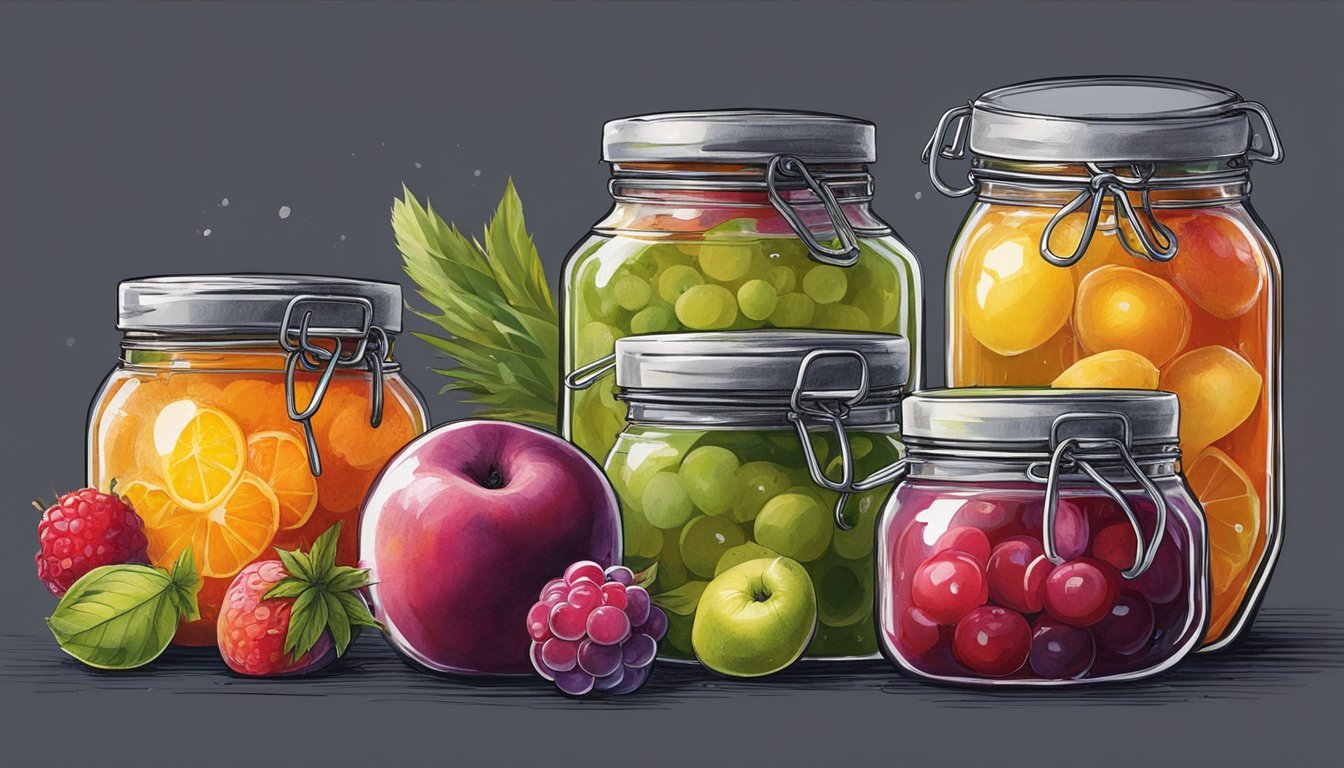Swicy Condiment Creations
Innovative Twists on Classic Jams and Jellies
The versatility of jams and jellies as condiments extends far beyond the traditional breakfast toast topper. These sweet spreads crafted from fruit have found their way into a plethora of culinary creations, offering a delightful balance of fruitiness and sweetness that can enhance the flavors of various dishes. The art of making jams and jellies at home allows for customization and experimentation, turning one's kitchen into a playground for both traditional recipes and innovative "swicy" - sweet and spicy - concoctions. From the ripe berry flavor in a homemade strawberry jelly to the kick of a hot pepper jelly, these condiments offer a spectrum of tastes for the adventurous palate.
Creating jams and jellies begins with the careful selection of high-quality fruits (What wine goes well with fruits?), which are then simmered and often paired with ingredients like lemon, sugar, and pectin. The process might seem daunting, but the result is a range of textures and flavors unique to home preserving. For instance, a recipe may call for a water bath to soften the fruit or overnight straining to achieve that ideal smooth jelly texture. On the other end of the spectrum, mixing finely chopped red peppers with powdered pectin and a dose of sugar can yield a sweet and spicy red pepper jelly perfect for glazing meats or adding to a cheese platter.
Jams and jellies are more than just spreads; they serve as a base for a variety of fruity offerings that can be tailored to each season's bounty. With spring’s arrival, incorporating fresh, vibrant flavors like rhubarb, lemon-blueberry, or jalapeno into spreads can bring a touch of sweetness or an unexpected spicy twist to any meal. Whether it’s elevating a simple muffin or weaving complex flavors through a gourmet dish, these condiments hold a place of honor in the gastronomic world for their ability to merge the simplicity of fruit with the complexity of flavor development.
The Basics of Jam and Jelly Making
In making jams and jellies, one combines fresh fruits, sugar, and pectin to create a sweet spread with a distinct texture. Canning the mixture in jars preserves the flavor and longevity of these homemade delights.
Understanding the Ingredients
The foundation of jam and jelly making is predicated on the trinity of fruit, sugar, and pectin. Fruit provides the primary flavor and natural sweetness, whereas sugar not only sweetens but also helps with the gelling process. Pectin, a type of fiber found in fruits, is essential for achieving the desired texture of the jam or jelly.
Fruit selection:
Local, seasonal fruits provide superior flavor.
A combination of ripe and slightly under-ripe fruit can enhance gelling, with under-ripe fruit contributing additional pectin and acid.
Sugar's role:
Vital for preserving the spread.
Helps achieve the gel-like consistency.
Pectin:
Naturally occurring in fruits like apples and citrus.
Commercial pectin can be added to low-pectin fruits, like strawberries, to aid in setting.
Essential Equipment for Beginners
To start making jam and jelly, one needs a few basic tools that facilitate the cooking and canning process.
Basic equipment list:
Large pot for cooking fruit mixture.
Canning jars with lids and bands.
Jar lifter, for safely handling hot jars.
Funnel, to transfer jam or jelly into jars without spillage.
Ladle or large spoon for filling jars.
The Canning Process Explained
Canning jams and jellies entails sealing them in jars to create an airtight environment that allows for shelf stability. The hot water bath method is a popular technique employed by beginners.
Canning steps:
Fill the canning pot halfway with water; heat it until it reaches a rolling boil.
Prepare jars by sterilizing and filling them with the hot spread.
Submerge filled jars in boiling water, ensuring they are covered by at least one inch of water.
Process the jars according to the specific recipe's time once the water returns to a boil.
Food Safety and Storage
Following food safety guidelines is crucial to prevent spoilage and contamination of jams and jellies.
Safety tips:
Always start with clean equipment and jars.
Ensure jars are sealed properly after the hot water bath.
Storage:
Store canned goods in a cool, dark place.
Jams and jellies can also be stored in the freezer to extend shelf life.
Inspect stored jars regularly for signs of spoilage before consumption.
By strictly adhering to these steps and using the proper equipment and ingredients, one can create delicious homemade jams and jellies like watermelon jelly or apple jam that are safe to eat and share.
Creating Your First Batch
Embarking on the journey of home preservation opens up a world of vibrant flavors and personal touches one can add to their pantry. Making jam and jelly from fresh produce is a gratifying experience that yields delectable spreads perfect for many occasions. Below are specific instructions to guide one through the process of creating simple fruit jams and crafting jelly from scratch.
Simple Fruit Jam Recipes
For those new to making jams, starting with berries is an excellent choice due to their natural pectin content and bold flavors. Strawberry freezer jam is a beginner-friendly recipe that requires minimal cooking and showcases the fresh taste of strawberries. Here's a concise recipe to follow:
Ingredients:
4 cups crushed strawberries
4 cups sugar
1 package powdered fruit pectin
¾ cup water
Instructions:
Mix crushed strawberries and sugar in a large bowl and let stand for 10 minutes.
Boil water and pectin in a small pot until dissolved, then pour over the strawberry mixture.
Stir for 3 minutes and ladle into clean jars, leaving ½ inch of headspace.
Let the jars stand at room temperature for 24 hours before freezing.
Expand one's repertoire by exploring combinations like raspberry jam or a more complex strawberry basil jam, infusing traditional flavors with a hint of herbaceous freshness. A simple recipe for berry-basil limeade jam might include mashed mixed berries, chopped fresh basil, lime zest, and juice, cooked with sugar and pectin before being poured into sterilized jars.
Jelly from Scratch
Making jelly entails extracting the clear fruit juice and combining it with sugar and pectin. Lemon-blueberry jelly is a tart and sweet spread that highlights the citrus notes against the depth of the blueberries. The steps are straightforward:
Extracting Juice:
Crush blueberries and add a small amount of water.
Cook on medium heat until the blueberries release their juice.
Strain the mixture through a dampened jelly bag or cheesecloth without pressing to maintain clarity.
Making Jelly:
Measure the juice into a pot and add sugar in the ratio of ¾ cup sugar to 1 cup of juice.
Stir in powdered pectin and bring to a rolling boil, stirring constantly.
Boil for 1 minute, remove from heat, skim off any foam, and ladle into sterilized jars, leaving ¼ inch headspace.
Properly sealed and processed, homemade jellies can provide a delightful homemade touch to breakfasts and snacks for months.
Advanced Techniques and Flavors
Crafting unique condiments involves more than just mixing fruit and sugar; it's an art that plays on the subtle dance of flavors and techniques. This section explores how to push the boundaries of traditional preserves using innovative fruit combinations and adding aromatic spices and herbs.
Exploring Unusual Fruits and Combinations
Adventurous makers of jams and jellies seek out less traditional fruits and inventive pairings to excite the palate. Peaches and blackberries might be classic on their own, but combining them with plums can create a delightful Tri-Berry Jam. Another innovative blend, the Berry-Basil Limeade Jam, introduces a surprising herbal twist to the sweet-tart profile of berries and citrus. One can even look to carrot cake jam as a unique spread that marries the comforting flavors of carrot cake spices with the smooth texture of jam.
Rhubarb Marmalade: A tart option that pairs well with the soft sweetness of a freshly baked muffin.
Tri-Berry Jam: A medley of berries for a layered taste experience.
Berry-Basil Limeade Jam: A surprising savory-sweet combination, adding an herby complexity to the tanginess of lime.
Zucchini Peach Jelly: Illustrating the versatility of vegetables in jellies, this blend is as unexpected as it is tasty.
Pineapple-Rhubarb Jam: Tropical pineapple meets tangy rhubarb for a bold flavor duo.
Adding Spices and Herbs
Spices and herbs enhance the natural flavors of fruits, adding depth and complexity to jams and jellies. For instance, Pretty Peach Jam can be transformed with a hint of cinnamon or nutmeg, giving a warm undertone to its summery sweetness. When creating Rhubarb Jelly, incorporating vanilla or star anise can elevate its profile. The incorporation of spices and herbs is not merely for taste but also for the aromatic qualities they imbue. Blackberry Jam, when laced with lavender, becomes a sophisticated spread that pairs exceptionally with creamy cheeses.
Rhubarb Jelly: Add vanilla for a classic complement to rhubarb's tartness.
Pretty Peach Jam: Cinnamon teases out the spiciness in peach flavors.
Blackberry Jam: Lavender lends an elegant floral note to the deep fruitiness of the blackberries.
In experimenting with these flavor agents, it's crucial to maintain a balance so that the spices and herbs enhance, rather than overpower, the primary fruit's profile.
Savory Applications
Exploring the world of savory condiments, one finds innovative uses for jams and jellies that extend far beyond traditional sweet spreads. These savory creations accentuate dishes with a balance of heat and flavor, serving as versatile additions to a variety of meals.
Pepper Jellies and Spicy Preserves
Pepper jellies have carved out a niche in the condiment world by delivering a blend of sweetness and heat. Key ingredients like jalapeños, red peppers, and even habaneros are used to craft spreads that range from mildly spicy to daringly hot. Texas jalapeno jelly, known for its bold flavor, can elevate a simple cheese board or be used as a glaze to add a spicy kick to appetizers (What wine goes well with appetizers?). These jellies pair exceptionally well with cheeses and crackers, offering a delightful contrast of flavors when spread over toast or used as a dipping sauce.
Cheese Pairings:
Brie: Complemented by mild pepper jellies
Cheddar: Stands up to medium heat levels
Goat Cheese: Balances well with both sweet and spicy profiles
Cooking Applications:
Glaze for Grilled Meats
Topping for Burgers and Sandwiches
Spicy Base for Vinaigrettes
Tomato and Vegetable-Based Condiments
Tomato and vegetable-based condiments branch out into savory territory with a focus on robust flavors. These jellies and jams utilize a mixture of ripe tomatoes and vegetables, often highlighted with herbs and spices. Such condiments complement various dishes, from enhancing morning toast to transforming a regular cheese board into an intricate appetizer display. These preserves suit the role of a stand-alone spread or can be integrated into a meal as a flavor enhancer.
Usage Ideas:
As a base for marinara or pizza sauce
Layered in lasagna or mixed into pasta dishes
Swirled into soups or stews for added richness
Sweet Pairings and Dessert Recipes
Implementing jams and jellies into desserts transforms the humble spreads into complex flavor enhancers. They introduce a sweet component that can turn a simple ice cream or baked good into a gourmet experience.
Jam and Jelly in Baking
Jams make excellent fillings for pastries, adding moisture and depth of flavor. For instance, one can roll out puff pastry and integrate almond butter and jam before baking, yielding a delightful treat that marries fruitiness with nutty undertones. Additionally, incorporating jam into a homemade batter can result in moist cakes with vibrant streaks of fruit flavors.
Puff Pastry Fillings: Blend jams with almond butter, fold into puff pastry, and bake.
Cakes and Cupcakes: Swirl jam into batters for a fruity touch.
Jelly-Infused Ice Creams and Sorbets
Ice creams and sorbets gain an exciting twist with the infusion of jelly. Imagine a sweet and spicy red pepper jelly rippled through a creamy vanilla base; it creates a bold contrast that plays on both the heat from the peppers and the smooth sweetness of the cream. Sorbets can be enlivened with light, fruit-based jellies, delivering a refreshing zest that is ideal for warmer weather.
Spicy Inflections: Swirl spicy jelly into ice cream bases for a piquant kick.
Fruit Sorbets: Enhance sorbets with fruit jellies for amplified flavor.
Fruit Preserve Gifts and Packaging
When offering fruit preserves as gifts, the attractiveness of the presentation is almost as important as the quality of the product itself. Thoughtful packaging and labeling can transform a simple jar of jam or jelly into a delightful gift.
Creative Labeling and Presentation
Gift-givers should pay close attention to the labeling and presentation of their fruit preserve gifts. A printable label with a charming design can be adhered to the jar, providing space for details like the preserve's name, ingredients, and the date it was made. For a personal touch, add a handwritten note or a custom message.
Labels: Consider waterproof and smudge-proof labels for durability.
Sealing: Ensure proper sealing with either a wax seal or a quality lid to maintain freshness.
Tops: Decorate the lid with fabric or custom stickers to add visual appeal.
Jars: Use clear glass jars to showcase the preserve's color and texture.
Recipe Inclusion and Gift Baskets
Inclusion of the homemade jam or jelly recipe offers a personal and thoughtful addition to the gift, enabling the recipient to recreate it in their own kitchen. One can place the printed recipe within a small, elegant envelope and attach it to the jar, or include it as part of a recipe card collection within the gift basket.
Gift Baskets: Assemble a gift basket that pairs preserves with complementary items like artisanal bread, quality teas, or handcrafted utensils.
Packaging: Choose packaging that protects the jars while also displaying them attractively within the basket. Consider environmentally friendly options like biodegradable packing shred.
Homemade Jams: Emphasize the homemade nature of the jams by including a note about the source of the ingredients or the story behind the recipe's origin.
By focusing on these details, one can create a gift that is visually pleasing and conveys the care put into making the preserves.
Inspirational Ideas from Around the World
In the realm of condiments, inspiration often stems from traditional preserving methods and local ingredients. These practices showcase a region's cultural identity and contribute to the diverse world of flavors.
Cultural Influences on Preserving Techniques
In India, chutneys are a vibrant expression of creativity, merging fruits like mangoes and tamarinds with spices to create layers of complex flavors. They exemplify how preservation techniques can be both practical and artistic.
Moving to colder climates, in Europe, rhubarb is often harvested for preserves. The rhubarb jam stands out with its tartness, perfect when paired with buttery pastries. This fruit is typically an early spring crop and is cherished for its bright flavor and versatility.
Peaches, apples, and blackberries have been the backbone of American preserves, transforming seasonal bounties into year-long delights. The peach preserves of the Southern United States invoke a sense of nostalgia and comfort with their homely, sweet, and sometimes spiced qualities.
In the United Kingdom, blackberries are foraged from hedgerows and made into blackberry jam which is a staple at many breakfast tables. It's a simple joy that captures the essence of the fruitful autumn season.
Preserving fruits, such as apples, in the form of jams or jellies is an age-old tradition that spans across cultures. From the apple jams of North America to the spiced preserves found in European markets, apples prove to be a versatile and beloved ingredient in creating these sweet spreads.
The art of preservation reflects a deep understanding of local ingredients and serves as a canvas for creativity. These culinary traditions allow flavors to transcend borders, offering inspiration to those seeking to explore the world through taste.
Serving Suggestions and Pairings
The art of pairing sweet and spicy condiments, such as jams and jellies, elevates simple dishes to exquisite culinary experiences. This section focuses on optimizing these delectable spreads within two contexts: complementing cheeses on a board and brightening morning meals.
Building the Perfect Cheese Board
Crafting a cheese board that impresses involves thoughtful choices. Spicy pepper jelly pairs exquisitely with the creamy textures and cool flavors of cream cheese. For a straightforward and delightful appetizer, spread the jelly on crackers and place a dollop of cream cheese for a contrast of flavors.
Cheese Type Suggested Jam/Jelly Pairing Description Soft Cheese Hot Pepper Jelly The heat from the jelly cuts through the richness of soft cheeses (What wine goes well with soft cheeses?) like Brie. Aged Cheese Garlic Savory Jam The umami from the garlic complements the complex flavors of aged Gouda or Cheddar.
Consider also incorporating fresh fruit or a fruit-based spread to add sweet notes that dance with the savory highlights on the palate.
Breakfast Jams and Sweet Toppings
In the realm of breakfast, jams and jellies shine as versatile toppings. A sweet and spicy jelly transforms traditional toast into an invigorating morning treat. Spread it over buttered toast or pair with a mild cheese topping to balance the flavors.
They can also serve as a surprising twist to fruity breakfasts:
Toast: A layer of savory jam can redefine the classic toast, providing a burst of flavor.
Sweet Toppings: Blend spicy jellies with fruit to create a bold syrup for pancakes, waffles, or oatmeal.
Home Canning Mastery
Mastery in home canning can transform a kitchen hobby into a rich tradition of preserving flavors. Detail-oriented practices and the ability to solve common canning problems are crucial for enthusiasts looking to excel.
Perfecting Your Canning Skills
To perfect one’s canning skills, enthusiasts should focus on precision and cleanliness. Before starting, they should ensure they have the necessary equipment, including a food processor for reducing fruits, utensils for handling jars, and a hot water bath to seal jars properly.
Preparation: Use a food processor to uniformly chop fruits, achieving a consistent jam or jelly texture.
Canning Process:
Paring: Begin by carefully paring fruits, removing any blemishes or imperfections to maintain quality.
Jars: Sterilize jars and lids meticulously; any residue on the rims can prevent sealing.
Filling: Pour the prepared jam or jelly into jars, leaving appropriate headspace.
Sealing: Process jars in a hot water bath to ensure a safe, long-lasting seal.
Adhering to these steps helps maintain the flavor and longevity of homemade jams.
Troubleshooting Common Issues
Occasionally, one may encounter issues during the canning process. Each problem typically has a straightforward solution:
Seal Failure: If jars fail to seal, check the rim for residue and ensure the lid is properly positioned. Re-process the jars if necessary.
Crystallization: Crystallization in jellies can occur due to overcooking. To prevent this, maintain the correct cooking time and temperature.
Mold Growth: Mold can form if jars are not sealed correctly. Always use a hot water bath and store in a cool, dark place.
Effective troubleshooting often means returning to basics, such as ensuring the use of fresh produce or verifying that the utensils and jars have been properly sanitized before use. In instances where jams don't set, it may help to review pectin levels and acid balance in the recipe or to check if the jam has been cooked for the adequate amount of time.
The Role of Jams and Jellies in Modern Cuisine
Jams and jellies have evolved beyond traditional breakfast spreads, integrating themselves into various aspects of modern gastronomy. From enhancing the flavor profile of appetizers to serving as key ingredients in sophisticated cocktails, their versatility is extensive.
From Charcuterie to Cocktail Accents
Charcuterie (What wine goes well with charcuterie?) Boards: The inclusion of jams and jellies on charcuterie boards underscores their role in enlivening a variety of cured meats (What wine goes well with cured meats?) and artisan cheeses. The sweetness of fruit-based preserves contrasts and balances the saltiness of meats, while the subtle heat from pepper jellies complements bold cheeses with a spicy kick.
Fruit Jams: Often made from berries, apricots, or figs, fruit jams impart a sweet-tart flavor that accentuates the overall taste of a charcuterie array.
Pepper Jellies: Varieties incorporating fiery chilies or milder peppers add an unexpected dimension, elevating the experience with their complex sweet and spicy profiles.
Cocktail Accents: As mixologists explore more creative realms, jams and jellies are regularly summoned to infuse cocktails with a depth of flavor. They not only contribute to the drink's sweetness but also introduce a fruity or spicy note that can transform a simple concoction into a signature beverage.
Flavor Enhancers: A dollop of berry jam can brighten a cocktail, while a spoonful of marmalade adds a sophisticated, bitter-sweetness to whisky-based drinks.
Texture Modifiers: Beyond flavor, the gelatinous texture of jellies provides a smooth, sometimes slightly viscous mouthfeel, adding a layer of richness to each sip.
Sandwich Spreads and Appetizers: Jams and jellies have secured their place as a staple in the creation of diverse sandwiches and appetizers, where their usage transcends mere condiments. They can transform a simple meal into a delightful culinary adventure by adding a burst of sweetness or a hint of spice.
Sandwiches: When used as a spread, they can round out flavors in savory sandwiches, merging with meats and cheeses to create each bite's unique taste profile.
Appetizers: Creative chefs incorporate jams and jellies into appetizer recipes, either as a glaze on meatballs or as a dip for fried foods, marrying the sweet and savory elements seamlessly.
Sustainable Practices in Jam and Jelly Production
The production of jams and jellies represents not only a culinary tradition but also an opportunity for implementing sustainable practices. These practices can significantly reduce the environmental impact of production and contribute to a more sustainable food system.
Using Locally Sourced Produce
Producers can minimize carbon footprints by sourcing fruits from local farms. This approach supports community farmers and reduces transportation emissions. A prime example is the use of fresh, local apricot fruit in jam production, which is more sustainable than sourcing semi-finished products that require additional processing and extensive transport.
Local Farms: Sourcing from nearby growers.
Transport: Limiting emissions from long-distance transportation.
Fresh Fruit: Utilizing seasonally available produce.
Eco-Friendly Packaging Options
Selecting sustainable materials for packaging is vital. Glass jars, while traditional, can be heavy and energy-intensive to transport. However, they offer the advantage of being reusable and recyclable. To further reduce waste, producers can use eco-friendly sealing tops made from biodegradable materials.
Glass Jars: Reusable and recyclable, but weighty.
Sealing Tops: Options include biodegradable or recyclable materials.
Packaging Design: Minimizing materials used while ensuring product integrity.

